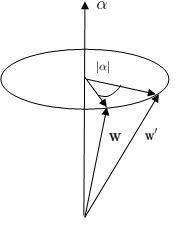Let us consider an infinitesimal rotation described by a vector  directed along the axis about which the rotation takes place and whose magnitude is the angle of the rotation. We then have
directed along the axis about which the rotation takes place and whose magnitude is the angle of the rotation. We then have

where  is the change in the position vector
is the change in the position vector  of the particle due to such a rotation.
of the particle due to such a rotation.
Let us now consider a function of position,  Substituting in the rotated coordinate and expanding to first order in
Substituting in the rotated coordinate and expanding to first order in  we obtain
we obtain
![{\displaystyle \psi \left(\mathbf {r} +\mathbf {\delta } \mathbf {r} \right)=\left[1+\mathbf {\alpha } \cdot \left(\mathbf {r} \times \mathbf {\nabla } \right)\right]\psi \left(\mathbf {r} \right)}](https://wikimedia.org/api/rest_v1/media/math/render/svg/d99b2c31922a1803151291484289e7efaec5551f)

Figure 1: Illustration of the rotation considered here.
The expression,

may therefore be interpreted as an operator that performs an infinitesimally small rotation of position coordinates. Noticing that

we may write this infinitesimal rotation operator as

Note that this expression only applies to infinitesimal rotations. We may construct a rotation operator for finite rotations, however, as follows. Let  be a finite rotation. Let us imagine performing this rotation as a sequence of
be a finite rotation. Let us imagine performing this rotation as a sequence of  rotations by
rotations by  where
where  is large. Each of these rotations may be treated as infinitesimal. The full rotation operator becomes
is large. Each of these rotations may be treated as infinitesimal. The full rotation operator becomes

If we now let  we obtain
we obtain

In this form, we recognize that angular momentum is a generator of rotations, similarly to how linear momentum generates translations.
The transformation rule for an operator is thus

This expression is valid for any rotation. We see that, if the operator commutes with both position and momentum, then it will remain unchanged by a rotation.
We can also calculate the effect of the unitary operator  on the wave function, as follows. We first determine the effect of the operator on a position eigenstate:
on the wave function, as follows. We first determine the effect of the operator on a position eigenstate:

As expected, the effect is to produce another position eigenstate, this one at the image of the rotation. The effect on the wavefunction is therefore as follows.

This is just the wave function evaluated at the rotated point.








![{\displaystyle \psi \left(\mathbf {r} +\mathbf {\delta } \mathbf {r} \right)=\left[1+\mathbf {\alpha } \cdot \left(\mathbf {r} \times \mathbf {\nabla } \right)\right]\psi \left(\mathbf {r} \right)}](https://wikimedia.org/api/rest_v1/media/math/render/svg/d99b2c31922a1803151291484289e7efaec5551f)













